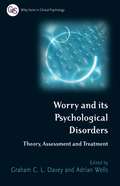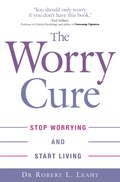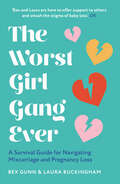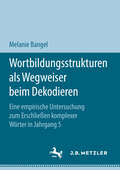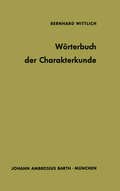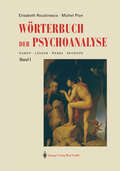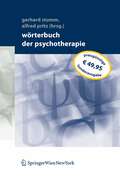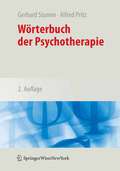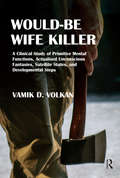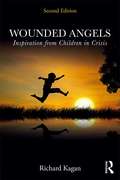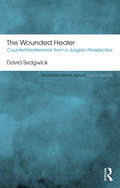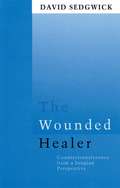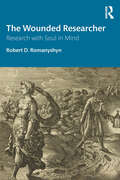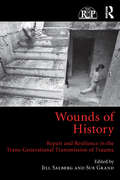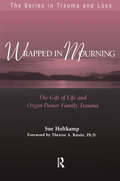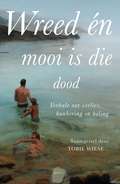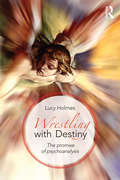- Table View
- List View
Worry and its Psychological Disorders: Theory, Assessment and Treatment (Wiley Series in Clinical Psychology)
by Graham C. L. Davey Adrian WellsAnxiety-based disorders are among the most common mental health problems experienced in the population today. Worry is a prominent feature of most anxiety-based disorders including generalized anxiety disorder, specific phobias, obsessive-compulsive disorder, panic disorder, and post-traumatic stress disorder. Written by international experts, Worry and its Psychological Disorders offers an up-to-date and complete overview of worry in a single volume. Divided into four sections, the book explores the nature of worry, the assessment of worry, contemporary theories of chronic and pathological worry, and the most recently developed treatment methods. It includes in-depth reviews of new assessment instruments and covers treatment methods such as Cognitive Behavioural Therapy and Metacognitive Therapy. Useful case studies are also included. This important volume provides an invaluable resource for clinical practitioners and researchers. It will also be of relevance to those studying clinical or abnormal psychology at advanced level.
The Worry Cure: Stop worrying and start living
by Dr Robert L. LeahyDo you worry that you'll say the wrong thing, wear the wrong outfit, or look out of place? Or maybe that you'll make a mistake at work, disappoint your partner, or overlook a serious health problem? Or perhaps you just worry too much - constantly running what-if scenarios through your head? Of course you do - we all do. Worry is a central issue in many people's lives; 38% of people say they worry every day. In this groundbreaking book, Dr Robert Leahy offers new insight, advice and practical techniques for everyone who has ever had a sleepless night. Using the most recent research and his 25 years of experience treating patients, Dr Leahy helps us understand why we worry and how best to defeat it. In his easy-to-follow-programme, he tells you how to: Identify productive and unproductive worry; Accept reality and commit to change; Turn 'failure' into opportunity; Use your emotions rather than worry about them. Combining stories from his practice with unique approaches to reducing worry, The Worry Cure is an essential companion for everyone who is anxious.
The Worst Girl Gang Ever: A Survival Guide For Navigating Miscarriage And Pregnancy Loss
by Laura Buckingham Bex Gunn‘Bex and Laura really have pieced together the parachute we all need to help us land safely after falling into the world of loss and fertility struggles.’ Elle Wright, author of A Bump In The Road
Wortbildungsstrukturen als Wegweiser beim Dekodieren: Eine empirische Untersuchung zum Erschließen komplexer Wörter in Jahrgang 5
by Melanie BangelMelanie Bangel geht in dieser Studie der Frage nach, inwiefern stärkere und schwächere Leserinnen und Leser Einsicht in Wortbildungsstrukturen für die Bedeutungszuweisung beim Lesen nutzen. Dazu erhebt sie (retrospektive) metakognitive Verbalprotokolle mit Schülerinnen und Schülern in Jahrgang 5 über die Bedeutung von kontextuell eingebetteten und isoliert schriftlich präsentierten komplexen Wörtern sowie über die den Bedeutungshypothesen zugrundeliegenden Worterschließungsstrategien. In den Analysen kommen unterschiedliche Vorstellungen zum Zusammenhang zwischen Wort(bildungs)struktur und Bedeutung zum Vorschein. Die Ergebnisse zeigen, dass sich die lesestärkeren und leseschwächeren Schülerinnen und Schüler vor allem darin unterscheiden, inwiefern sie den Kotext als Informationsquelle hinzuziehen und ob sie morphologisches Wissen als wortübergreifendes Problemlösewissen abrufen können.
Wörterbuch der Charakterkunde: Die Bedeutung der gebräuchlichen Charakterbezeichnungen
by B. WittlichWörterbuch der Psychoanalyse: Namen, Länder, Werke, Begriffe
by Elisabeth Roudinesco Michel PlonDas Wörterbuch der Psychoanalyse informiert über die wichtigsten Elemente des psychoanalytischen Denkens: die wesentlichen Begriffe, die wichtigsten Länder, in denen die Psychoanalyse Fuß fassen konnte, die Biographien ihrer Autoren, psychopathologische Theorien und andere Wissensbereiche oder intellektuelle, politische und religiöse Bewegungen, die von der Psychoanalyse beeinflusst wurden, die wichtigen ersten Fallbeschreibungen, die Behandlungstechniken sowie die Ansichten der Psychoanalyse zu Geburt, Familie, Geschlecht und Wahn. Es behandelt auch den Freudianismus selbst, seine Geschichte und seine unterschiedlichen Schulen, und gibt einen Überblick über die wichtigsten Werke Freuds. Es schließt die Familie Freuds mit ein, außerdem seine Lehrer sowie Schriftsteller und Künstler, mit denen er Briefwechsel unterhielt. Jeder Artikel enthält eine Bibliographie mit den wichtigsten Quellen. Eine Zeittafel mit den bedeutendsten Ereignissen der Geschichte der Psychoanalyse rundet dieses Wörterbuch ab.
Wörterbuch der Psychotherapie
by M. Voracek P. GumhalterKonkurrenzloses Lexikon und wertvolles Nachschlagewerk – methodenübergreifend und methodenbezogen: 1.315 Stichwörter zu den wesentlichen Begriffen der modernen Psychotherapie. 360 Autoren/innen aus 14 Ländern beteiligten sich an dem Werk, das 51 Fachbereiche bzw. psychotherapeutische Ansätze einbezieht. Die Begriffe sind mit Querverweisen vernetzt und bieten 4.500 weiterführende Quellenangaben. Aus den Rezensionen: "... Dieses Buch muss empfohlen werden, es … ist außerordentlich gelungen ..." (in: Psychotherapie Forum 1/2001) "... Logisch und übersichtlich gestaltet, … ein wertvolles Nachschlagewerk …" (in: Medical Tribune, 27. 9. 2000)
Wörterbuch der Psychotherapie
by Martin Voracek Paul GumhalterMethodenübergreifend und methodenbezogen erläutern 360 Autorinnen und Autoren aus 14 Ländern in mehr als 1300 Stichwörtern die wesentlichen Begriffe der modernen Psychotherapie. Die Stichwörter sind untereinander mit Querverweisen vernetzt und bieten insgesamt 4500 weiterführende Quellenangaben. Die Neuauflage wurde durch einen Personenteil ergänzt, in dem 25 wichtige Gründerpersönlichkeiten vorgestellt werden: mit Bild und Text zu Lebensdaten, Schaffensperioden, theoretischen Schwerpunkten und ihren Verdiensten für die Psychotherapie.
Would-Be Wife Killer: A Clinical Study of Primitive Mental Functions, Actualised Unconscious Fantasies, Satellite States, and Developmental Steps
by Vamik D. VolkanThe author believes that studying a therapeutic process closely from its beginning to its termination is one of the best ways to observe, learn, and teach psychoanalytic concepts. This book is unusual since it describes a man's drastic internal psychological changes over forty years. He was thirty-nine years old when he wanted to cut off his wife's head with an axe and he was hospitalized; previous to this incident he had delusions and hallucinations. He died at age eighty-two as a beloved community leader. The author provides clinical illustrations of primitive transference and counter transference manifestations. He defines "satellite states" in which an individual finds a balance between experiencing individuation and remaining dependent on the Other and "crucial juncture" experiences that are necessary to learn how to integrate self and object images and move up the developmental steps. Various concepts such as the replacement child, actualized unconscious phantasy, emotional flooding, and linking interpretation and therapeutic play are explored.
Would-Be Wife Killer: A Clinical Study of Primitive Mental Functions, Actualised Unconscious Fantasies, Satellite States, and Developmental Steps
by Vamik D. VolkanThe author believes that studying a therapeutic process closely from its beginning to its termination is one of the best ways to observe, learn, and teach psychoanalytic concepts. This book is unusual since it describes a man's drastic internal psychological changes over forty years. He was thirty-nine years old when he wanted to cut off his wife's head with an axe and he was hospitalized; previous to this incident he had delusions and hallucinations. He died at age eighty-two as a beloved community leader. The author provides clinical illustrations of primitive transference and counter transference manifestations. He defines "satellite states" in which an individual finds a balance between experiencing individuation and remaining dependent on the Other and "crucial juncture" experiences that are necessary to learn how to integrate self and object images and move up the developmental steps. Various concepts such as the replacement child, actualized unconscious phantasy, emotional flooding, and linking interpretation and therapeutic play are explored.
Wounded Angels: Inspiration from Children in Crisis, Second Edition
by Richard KaganWounded Angels: Inspiration From Children in Crisis uses vignettes of children in crisis situations to portray how troubling behaviors can act as clues for ways children can grow stronger after traumatic stress. This text shows how children can guide caregivers and practitioners through hidden conflicts and, through case examples, provide opportunities to develop emotionally supportive relationships. Practitioners and caregivers can use Wounded Angels to encourage a resilient perspective for children. In return, this text informs readers how children find their own path towards healing.
Wounded Angels: Inspiration from Children in Crisis, Second Edition
by Richard KaganWounded Angels: Inspiration From Children in Crisis uses vignettes of children in crisis situations to portray how troubling behaviors can act as clues for ways children can grow stronger after traumatic stress. This text shows how children can guide caregivers and practitioners through hidden conflicts and, through case examples, provide opportunities to develop emotionally supportive relationships. Practitioners and caregivers can use Wounded Angels to encourage a resilient perspective for children. In return, this text informs readers how children find their own path towards healing.
Wounded Bird of Paradise (PDF)
by Mary EssingerWhen Mabelline sets out on a journey to visit her pen pal Rosa, she doesn't expect to be staying quite as long as she does. Mabelline quickly takes Rosa and her son Carlos to her heart, but she knows right away there is something different about the boy. When tragedy occurs, Mabelline becomes responsible for Carlos as he struggles to fit into a world based on rules he doesn't understand, and finds himself in serious trouble. This unlikely pair takes us on an emotional journey that warms the heart whilst illustrating the difficulties someone with Asperger Syndrome encounters trying to hold down a job as a flower grower, make friends, talk to girls, and cope with life.
The Wounded Healer: Countertransference from a Jungian Perspective (Routledge Mental Health Classic Editions)
by David SedgwickIn the years since the publication of The Wounded Healer, countertransference has become a central consideration in the analytic process. David Sedgwick’s work was ground-breaking in tackling this difficult topic from a Jungian perspective and demonstrating how countertransference can be used in positive ways. Sedgwick’s extended study of the process candidly presents the analyst’s struggles and shows how the analyst is, as Jung said, "as much in the analysis as the patient." The book extends Jung’s prescient work on countertransference to create a dynamic view of the analyst-patient interaction, stressing the importance of the analyst’s own woundedness and how this may be used in conjunction with the patient’s own. Sedgwick begins with a discussion of the need and justification for a Jungian approach to countertransference, then reviews Jungian theories and presents detailed illustrations of cases showing the complexity of transference-countertransference processes in both the patient and the analyst, and concludes with a model of countertransference processing. This Classic Edition also includes a new introduction by the author. It will be an important work for Jungian analysts, psychotherapists and other clinicians and students interested in the struggles of the therapeutic process.
The Wounded Healer: Counter-Transference from a Jungian Perspective (Routledge Mental Health Classic Editions)
by David SedgwickCountertransference is an important part of the analytical process. It is concerned with the analyst's emotional response to the patient. As such, it can be a particularly difficult aspect of the analytical setting and especially so because of the threat of possible sexual involvement with the patient. At present there is little available on this difficult topic. Jungian analyst David Sedgwick tackles the subject bravely and shows how to use the countertransference in a positive way. The result is one of the finest Jungian clinical texts of recent years.
The Wounded Healer: Counter-Transference from a Jungian Perspective (Routledge Mental Health Classic Editions)
by David SedgwickCountertransference is an important part of the analytical process. It is concerned with the analyst's emotional response to the patient. As such, it can be a particularly difficult aspect of the analytical setting and especially so because of the threat of possible sexual involvement with the patient. At present there is little available on this difficult topic. Jungian analyst David Sedgwick tackles the subject bravely and shows how to use the countertransference in a positive way. The result is one of the finest Jungian clinical texts of recent years.
The Wounded Healer: Countertransference from a Jungian Perspective (Routledge Mental Health Classic Editions)
by David SedgwickIn the years since the publication of The Wounded Healer, countertransference has become a central consideration in the analytic process. David Sedgwick’s work was ground-breaking in tackling this difficult topic from a Jungian perspective and demonstrating how countertransference can be used in positive ways. Sedgwick’s extended study of the process candidly presents the analyst’s struggles and shows how the analyst is, as Jung said, "as much in the analysis as the patient." The book extends Jung’s prescient work on countertransference to create a dynamic view of the analyst-patient interaction, stressing the importance of the analyst’s own woundedness and how this may be used in conjunction with the patient’s own. Sedgwick begins with a discussion of the need and justification for a Jungian approach to countertransference, then reviews Jungian theories and presents detailed illustrations of cases showing the complexity of transference-countertransference processes in both the patient and the analyst, and concludes with a model of countertransference processing. This Classic Edition also includes a new introduction by the author. It will be an important work for Jungian analysts, psychotherapists and other clinicians and students interested in the struggles of the therapeutic process.
The Wounded Researcher: Research with Soul in Mind
by Robert D. RomanyshynThe Wounded Researcher addresses the crises of epistemological violence when we fail to consider that a researcher is addressed by and drawn into a work through his or her complexes. Using a Jungian-Archetypal perspective, this book argues that the bodies of knowledge we create degenerate into ideologies, which are the death of critical thinking, if the complexity of the research process is ignored. Writing with soul in mind invites us to consider how we might write down the soul in writing up our research.
The Wounded Researcher: Research with Soul in Mind (Studies In Archetypal Psychology)
by Robert D. RomanyshynThe Wounded Researcher addresses the crises of epistemological violence when we fail to consider that a researcher is addressed by and drawn into a work through his or her complexes. Using a Jungian-Archetypal perspective, this book argues that the bodies of knowledge we create degenerate into ideologies, which are the death of critical thinking, if the complexity of the research process is ignored. Writing with soul in mind invites us to consider how we might write down the soul in writing up our research.
Wounds of History: Repair and Resilience in the Trans-Generational Transmission of Trauma (Relational Perspectives Book Series)
by Jill Salberg and Sue GrandWounds of History takes a new view in psychoanalysis using a trans-generational and social/political/cultural model looking at trauma and its transmission. The view is radical in looking beyond maternal dyads and Oedipal triangles and in its portrayal of a multi-generational world that is no longer hierarchical. This look allows for greater clinical creativity for conceptualizing and treating human suffering, situating healing in expanding circles of witnessing. The contributors to this volume look at inherited personal trauma involving legacies of war, genocide, slavery, political persecution, forced migration/unwelcomed immigration and the way attachment and connection is disrupted, traumatized and ultimately longing for repair and reconnection. The book addresses several themes such as the ethical/social turn in psychoanalysis; the repetition of resilience and wounds and the repair of these wounds; the complexity of attachment in the aftermath of trauma, and the move towards social justice. In their contributions, the authors remain close to the human stories. Wounds of History will be of interest to psychoanalysts, psychologists and other mental health professionals, as well as students or teachers of trauma studies, Jewish and gender studies and studies of genocide.
Wounds of History: Repair and Resilience in the Trans-Generational Transmission of Trauma (Relational Perspectives Book Series)
by Jill Salberg Sue GrandWounds of History takes a new view in psychoanalysis using a trans-generational and social/political/cultural model looking at trauma and its transmission. The view is radical in looking beyond maternal dyads and Oedipal triangles and in its portrayal of a multi-generational world that is no longer hierarchical. This look allows for greater clinical creativity for conceptualizing and treating human suffering, situating healing in expanding circles of witnessing. The contributors to this volume look at inherited personal trauma involving legacies of war, genocide, slavery, political persecution, forced migration/unwelcomed immigration and the way attachment and connection is disrupted, traumatized and ultimately longing for repair and reconnection. The book addresses several themes such as the ethical/social turn in psychoanalysis; the repetition of resilience and wounds and the repair of these wounds; the complexity of attachment in the aftermath of trauma, and the move towards social justice. In their contributions, the authors remain close to the human stories. Wounds of History will be of interest to psychoanalysts, psychologists and other mental health professionals, as well as students or teachers of trauma studies, Jewish and gender studies and studies of genocide.
Wrapped in Mourning: The Gift of Life and Donor Family Trauma (Series in Trauma and Loss)
by Sue HoltkampBased on 15 years of experience working with organ procurement organizations and donor families, Wrapped in Mourning addresses the heretofore unexplored subject of organ donor family trauma. This book covers the issues surrounding organ donation, including the history of organ transplantation, how organs are procured for transplantation, as well as the medical procedure itself. Each issue is explored with regards to its impact upon donor families. Ways to reduce grief, prevent problems, and increase the benefits of donating organs for the donating family are also discussed.
Wrapped in Mourning: The Gift of Life and Donor Family Trauma (Series in Trauma and Loss)
by Sue HoltkampBased on 15 years of experience working with organ procurement organizations and donor families, Wrapped in Mourning addresses the heretofore unexplored subject of organ donor family trauma. This book covers the issues surrounding organ donation, including the history of organ transplantation, how organs are procured for transplantation, as well as the medical procedure itself. Each issue is explored with regards to its impact upon donor families. Ways to reduce grief, prevent problems, and increase the benefits of donating organs for the donating family are also discussed.
Wreed en mooi is die dood: Verhale oor verlies, hunkering en heling
by Tobie WieseAl is die dood ’n feit soos ’n koei, vermy die meeste van ons dit om daaroor te dink of te praat. Hierdie boek probeer om dié stilte te verbreek.In Wreed én mooi is die dood deel bekende Afrikaanse skrywers hulle verhale oor verlies en heling. Dit bied insig in hoe om die trauma van ’n geliefde se dood te hanteer en jou eie sterflikheid te konfronteer.Só skryf Marita van der Vyver roerend oor haar babaseun se dood, terwyl Valda Jansen beskryf hoe sy aanvanklik lamgelê is deur die nuus dat sy kanker het en Kerneels Breytenbach vertel hoe sy vrou se sterwe hom tot selfkennis gelei het.’n Jong paramedikus berig oor sy gereelde ontmoetings met die dood en ’n sterwensbegeleier vertel hoe dit moontlik is om hierdie wêreld blymoedig te verlaat. Daar is selfs ’n bietjie humor... soos die storie oor die jong dominee wat in ’n leë graf beland het en Annelie Botes se lang lys voorskrifte vir haar begrafnis.Die dood is wreed ja, maar dit kan – verrassend genoeg ̶ ook mooi wees.
Wrestling with Destiny: The promise of psychoanalysis
by Lucy HolmesCan psychoanalysis help people control their destinies? Using empirical evidence from neuroscience, Lucy Holmes makes a powerful argument that it can. This book considers the various ways in which destiny is linked to the repetition compulsion, and how free association in psychoanalysis can literally change the mind in ways that can help people reshape and take control of the future. Freud’s psychoanalysis is revealed here to be startlingly modern in its consonance with the latest findings in the study of the brain. The compulsion to repeat can propel human beings toward destinies they would never have consciously chosen. The tenacity of this human tendency can inhibit our ability to meet life’s challenges. These challenges include our gender; an inability to master the complexities of loving and the strains of marriage; fears regarding the impertinence of being successful; the unconscious, reptilian pleasure we derive from going to war and raping the planet; and the inexorable decline and decay of our mortal flesh. This book argues that the evolved talking that occurs in the psychoanalytic process can change the chemistry and structure of the brain in a way that helps the talker face these challenges and take charge of his or her own destiny. The author presents a cogent hypothesis spanning brain and mind to clarify how the basic rule of psychoanalysis - "just say everything" - can actually cure. This will appeal to mental health professionals such as psychoanalysts and psychotherapists, and students at the post-graduate level, as well as the general interested reader.
